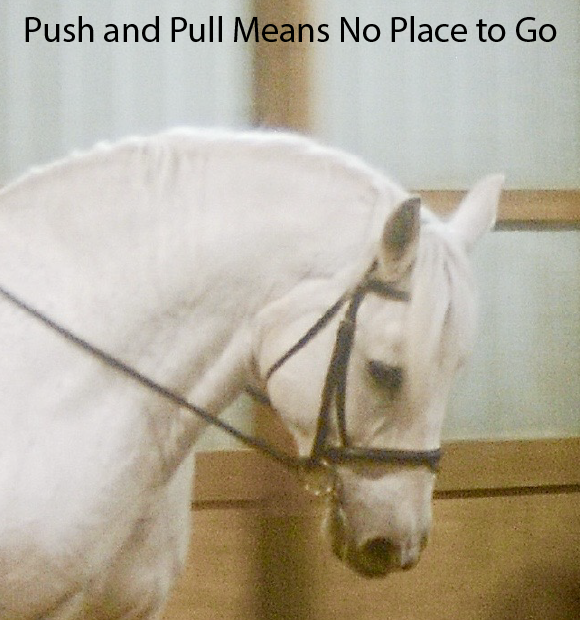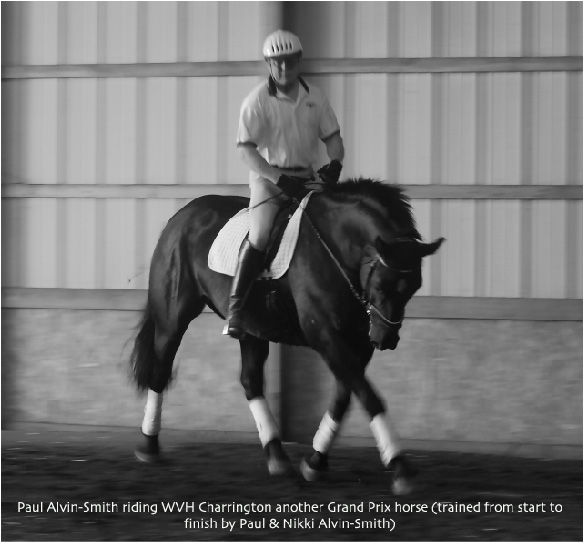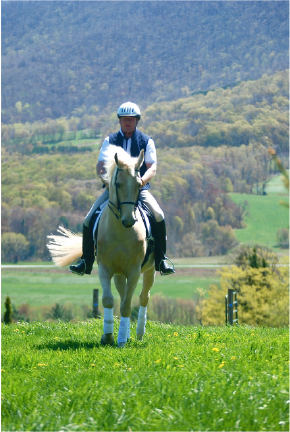Push and Pull Means No Place to Go
By Nikki Alvin-Smith

The nemesis of every rider particularly in the early stages of riding is the push and pull factor. We have all seen the big moving Warmbloods hounded by the rider’s forceful seat and leg aids, boxed into the rider’s unrelenting hands. In fact the more extravagant moving your horse of any breed, the more likely it is you will go to the rein to help support your seat.
Over the years I have imported many horses from Europe. If you have ever ridden or bought one of these big-moving horses home, you know that when you first sit aboard these talented beasts your arms are pulled out of your sockets. Brace your back. No joke. In order to exact the most movement on sale horses the classical approach to training the horse is often overlooked. This is especially true of horses trained up in a rush for the auctions in Europe, where maintenance of purity of the gaits is often disregarded in order to showcase the maximum extravagance of movement possible.
Even riders with brilliant seats use reins to re-balance, not just their horse, but themselves. Habits die-hard and the bigger moving horses are a class act at causing mayhem through transitions for the rider used to a smaller gaited horse.
Regardless of the breed or talent of your horse it is important to equip yourself and your students with the right tools in their toolbox to ensure there is no push and pull on the horse which leaves the horse with nowhere to go and will result in either a horse that ‘switches off’ when ridden and has no forward movement at all or create a tense horse. Either horse is an unhappy horse.
Let’s take a look at how to fix this common problem.
One. Two. Three.
Apply the one, two, three rule rigorously. That is, the horse must answer the forward aid of the leg and step forward promptly. A small squeeze of your leg aids at the walk should move your horse forward from the halt. Once in the walk, use alternate leg aids, in time with the forward hind end footfall.
If you ask your horse once and he does not respond, immediately use the aid again this time slightly stronger. If he does not respond, tap him with a whip behind your heel. However he moves forward, a lurch or a bounce or even into a trot, be certain not to hit him in the mouth with your rein aids. It is also important that you reward him for responding in whatever forward method he chose. Use your voice and pat him to tell him how good he was and simply sit tall and breathe in to bring him back to the walk.
Remember riding is not about pulling or pushing, it is about releasing. You cannot re-use any aid if it just stays there. So tapping with the leg is better than holding
.
The Reins
The soft release of the inside rein should be timed exactly to the inside hind leg forward footfall and the left seat bone will hop from left to right with no 'unihip' sitting to the trot. This is especially important in the upward and downward transitions. Close your fingers softly (‘Sally Swift’ bird like hold), and ride with pressure on the thumb and forefinger only. Most importantly your wrists should not be turned. The outside frame will run from elbow to flat back of the hand to rein to bit and your elbows will be resting at a right angle almost touching your waist. Your hands will be following the movement, not holding it. The horse must hold himself.
One of my favorite expressions when teaching is to tell the student, "We are not carrying tea on a tray to the Queen." Are you a butler in the saddle? Relax. Put your shoulders back, let your arms hang in their natural position at your side and with your elbows just there, adjust your rein length. Of course the vertical line is basic, the heel, the hip, the elbow, the ear. Can you maintain it during transitions? Can you follow the horse's back with a left/right hip movement in the sitting trot and remember to breathe or do you bump up and down with a unihip?
Timing is Everything
To follow the horse’s back and movement and to time your aids correctly is harder to do than you think. Have a friend take a video of you in action.
Are you prepared in your core to absorb the forward movement by releasing your breath in time with the aid request? Whatever discipline you ride you need to address your aid timing. Driving aids such as leg and seat should always come in advance of a rein aid. For example in dressage training: In your pre-canter pirouette do you have a bouncy energetic forward canter with lots of pop and soft following hands? Or have you pulled your horse into a tight back with your tense seat and effort to turn your head to your forthcoming movement with a stiff neck and braced back? Our serious faces and unsmiling mouths tense our jaw and you will find this results in your horse tensing his jaw. Smile a little. Smile a lot. Can you see your horse smiling yet with a soft jaw and relaxed eye and listening ears?
Amazingly students who make this repair to their riding habit and address their deficiencies are surprised with the immediate improvement in all their 'work'. Be it piaffe, half passes or counter canter. The quality of any transition, within the gait and between gaits, determines the outcome of the next movement. For hunter/jumper riders or eventers the horse will be between your seat and hand and working in front of your leg, which provides automatic power steering between and before fences.

This horse and rider shown in the photo here showcases great suppleness and the horse exhibits great trust in the hand. I know the rider had previously broken both his arms, one arm at the shoulder and one arm at the wrist (that was not set properly). So we can forgive the elbows not being completely at the waist. This is a suppling exercise recheck to show the horse is over his back and soft in his jaw. Note the expressive front leg of the horse and nice track on the circle. Notice the listening ears and relaxed tail of the horse and a slight waist turn to the right for the rider with the rider's chin up and inside leg perfectly placed. This horse has also been blessed by never having been ridden by anyone without a truly independent seat. Not all horses have been this fortunate.
Exercises to Help
In my experiences as a clinician I find students are also surprised to find they have fallen prey to the habit of 'holding'. The worst offenders will find their horse may fall to his forehand in the first few tries. The remedy is go to circle work, come down a gait. Repeat exercise. Just before the horse 'drops' make a downward transition and repeat. You can also take your horse's head to the outside and repeat. This works better on the full arena for a young unbalanced horse. Never ride your horse with his head entirely straight. I'm not talking about tipping his head. That won't do. But you should just see his eye.
 I prefer to work my horses with their eye to the outside more of the time than inside. But it depends on a number of factors; your horse and his balance; his conformation; what you are schooling; which side, his stiff or hollow side; which side, your stiff or hollow side. Repeat the work until your horse says, "Aah, yes, I see, this is my job and I am happy to do it." Praise him.
I prefer to work my horses with their eye to the outside more of the time than inside. But it depends on a number of factors; your horse and his balance; his conformation; what you are schooling; which side, his stiff or hollow side; which side, your stiff or hollow side. Repeat the work until your horse says, "Aah, yes, I see, this is my job and I am happy to do it." Praise him.
When trainers like Klaus Balkenhol tell their students, “Go back to basics and then the rest will follow,” they are not kidding. How many Grand Prix riders would agree that their most improved tests came after such basic corrective reasoning from a ground person that was not shy to say just what they saw.
For myself working in Germany with Herbert Rehbein, a master of few words but much input, was invaluable in correcting many poor habits I had developed over the years. Working with the Rehbein threshold with no tolerance for the push and pull, certainly weeded out this rider trying to correctly absorb the big forward movement. Humiliating at first. But once I realized I needed to just make three good strides then bring the horse down a gait or collect the gait, before I lost my position and good feelings, it became quite easy. You don't need to visit Grunwoldhof to learn to ride correctly, a good trainer with a decent eye can be your ground person. All trainers need a trainer!
Other iconic names such as George Morris also consistently discuss the timing of the aids with their students, even their most advanced and successful ones are taken to task if they have compromised their timing of the aids are have resorted to a push/pull riding style.
Get religious about the timing an application of your aids. Your horse will love it.
Once these basic tenets of aid timing and application are consistently met you can address the fine-tuning of your horse with the refining half-halt. What are those little fingers for after all? Stay tuned. We shall find out.
About the author: Nikki Alvin-Smith is an international Grand Prix dressage trainer/clinician who has competed in Europe at the Grand Prix level earning scores of over 72%. Together with her husband Paul, who is also a Grand Prix rider, they operate a private horse breeding/training farm in Stamford, NY.


